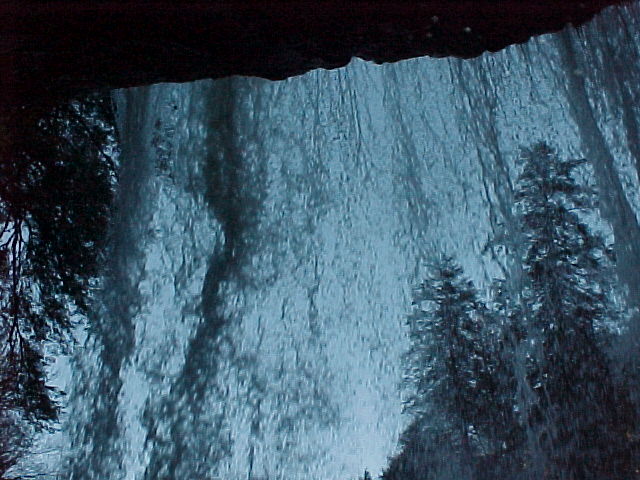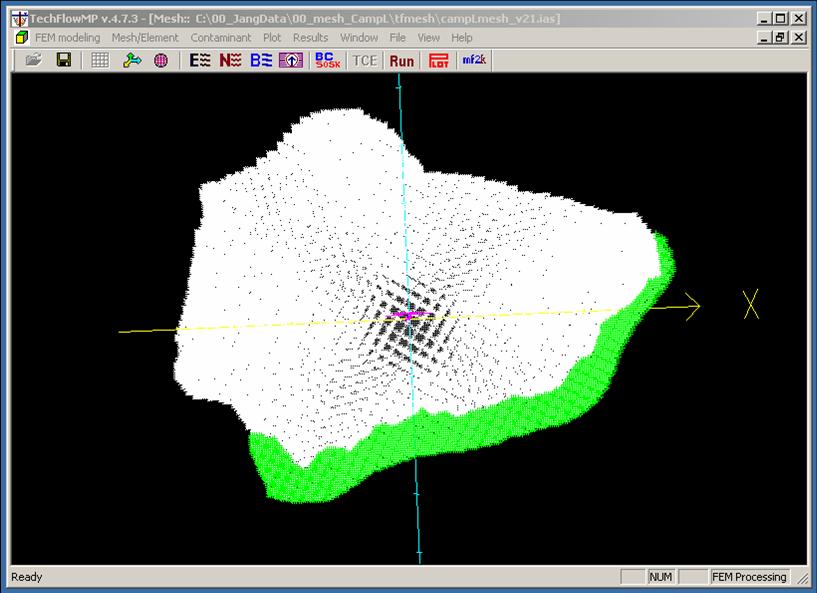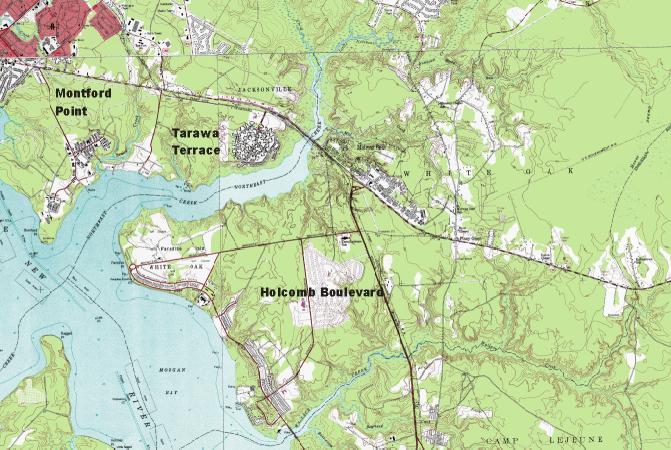





CAMP LEJEUNE (NC) ENVIRONMENTAL CONTAMINATION and MANAGEMENT:
Research Group: J. Wang, W. Jang, J. Guan, M. Maslia, B. Faye and M. M. Aral
Introduction
In 1990, the Agency for Toxic Substances and Disease Registry (ATSDR) completed a Public Health Assessment (PHA) of a dry-cleaning facility-ABC One Hour Cleaners-located about 500 ft from U.S. Marine Corps Base Camp Lejeune, North Carolina (ATSDR 1990). The assessment established the site as a source of volatile organic compound (VOC) contamination for some of the base's water-supply wells. A 1997 PHA for Camp Lejeune (ATSDR, 1997) reviewed data and assessed environmental exposures to drinking water supplies at the military base. The assessment determined that the estimated drinking water VOC exposures at Camp Lejeune were several thousand times lower than levels of concern in animal studies. They were also hundreds of times lower than levels linked to health effects found in workplace studies. ATSDR concluded that both cancer and non-cancer health effects were unlikely in adults exposed to VOC-contaminated drinking water at Camp Lejeune based on worst-case estimates. However, because of the limited information available in the scientific literature on how these chemicals might effect a fetus or a child, it was suggested that an epidemiological study be conducted at Camp Lejeune to evaluate whether mothers exposed during pregnancy to chlorinated solvents in drinking water-tetrachloroethylene (PCE) and trichloroethylene (TCE)-had a higher risk of giving birth to a child with a birth defect or a childhood cancer.
As a first step in following up on the PHA recommendation to conduct an epidemiologic study, ATSDR conducted an epidemiologic study of exposure to VOC-contaminated drinking water and mean birth weight, small for gestational age, and preterm birth in residents of base family housing at Camp Lejeune (ATSDR, 1998; Sonnenfield, 2001).This study obtained electronic birth certificate information for live births born during the period January 1, 1968¬December 31, 1985 to women who resided in base family housing at time of delivery. 11,970 live births were included in the analyses. The year 1968 was chosen as the starting point of the study because that was the year that North Carolina began computerizing its birth records. Information from the birth certificate was used to determine birth weight and gestational age.
Because the adverse birth outcome study relied on birth certificate information, it could not evaluate birth defects or childhood cancers. In order to evaluate these outcomes, ATSDR initiated a case-control design epidemiologic study of specific birth defects-neural tube defects and oral cleft defects-and childhood leukemia among births occurring during the period 1968¬1985 to mothers residing at the base anytime during their pregnancy. In 2004, the study protocol received approval from the Centers for Disease Control (CDC) Institutional Review Board and the U.S. Office of Management and Budget.
To provide the study with quantitative estimates of exposure, characterization of environmental contamination and the frequency and duration of exposure to contaminated drinking water needs to be conducted. Thus, ATSDR/MESL has embarked on a program of geohydrologic characterization, groundwater flow, fate and transport modeling, and water distribution system modeling to enable the historical reconstruction of water-distribution systems serving Camp Lejeune. Information contained on this web site, when fully completed, will describe data collection activities, field investigations, and modeling analyses of groundwater resources and evaluation of present-day (2004) water distribution systems at Camp Lejeune.
Background
U. S. Marine Corps Base Camp Lejeune encompasses an area of about 164 mi2. It is located in the Coastal Plain of North Carolina, in Onslow County, southeast of the City of Jacksonville and about 70 miles northeast of the City of Wilmington. The base, bordered on the east by the Atlantic Ocean, serves a population of over 100,000 military personnel and their dependents. The major cultural, geographic, and hydrologic features of the base are shown in site figure. Base housing for enlisted personnel, officers, and their families are located in 15 different areas on the base (ATSDR 1998). To supply water for base activities, including housing, more than 100 groundwater wells have been drilled. Almost all of the wells withdraw water from the permeable Castle Hayne aquifer which is composed of 60 to 90 percent sand and limestone (Harned et al., 1989, Cardinell et al., 1993).
The ATSDR epidemiologic study is trying to determine if there is an association between exposure to contaminated drinking water and birth defects among women who lived at Camp Lejeune while they were pregnant during the period 1968-1985. More than 12,000 pregnant women may have been exposed to well water contaminated with volatile organic compounds (VOCs) that was used for the potable water source and distributed through water-distribution systems at Camp Lejeune. As part of the epidemiologic study, characterization of environmental contamination and the frequency and duration of exposure to contaminated potable water needs to be conducted. In assessing exposure the following questions are being addressed:
• What was the source or sources of the contaminated potable water?
• Which chemicals or chemical compounds contaminated the water supplies?
• When did the contaminated groundwater reach the water-supply wells and what was the duration of the contamination?
• How was the contaminated water distributed throughout the water-distribution systems serving the Camp Lejeune base housing areas? and,
• What were the frequency, duration, and spatial distribution of exposure to the contaminated water?
Because exposure data are limited or non-existent during the period of interest (1968¬1985), ATSDR/MESL is using an historical reconstruction approach to quantify historical estimates of water supply and the distribution of contaminants in groundwater and water-distribution systems. This method, previously used for the childhood cancer cluster investigation at Dover Township (Toms River), New Jersey (Maslia et al., 2000, 2001; Aral et al., 2004a, b) relies on using computational tools (i.e., models) in conjunction with available data to answer the questions listed above. As part of the historical reconstruction effort for the Camp Lejeune study, the following data gathering, data analyses, and modeling activities are being conducted:
• Description of the geohydrologic framework;
• Development and calibration of groundwater flow models;
• Development and of groundwater fate and transport models;
• Conducting field tests (hydraulic and water quality) of the present-day (2004) water distribution systems; and,
• Development and calibration of present-day (2004) water-distribution system models.
References
Agency for Toxic Substances and Disease Registry (ATSDR). (1990). Public health assessment for ABC One Hour Cleaners, Jacksonville, Onslow County, North Carolina, u.S. Department of Health and Human Services, Atlanta, Georgia.
Agency for Toxic Substances and Disease Registry (ATSDR). (1997). Public health assessment for u.s. Marine Corps Base at Camp Lejeune, Military Reservation, Camp Lejeune, Onslow County, North Carolina, u.S. Department of Health and Human Services, Atlanta, Georgia.
Agency for Toxic Substances and Disease Registry (ATSDR). (1998). Volatile organic compounds in drinking water and adverse pregnancy outcomes, United Stated Marine Corps Base, Camp Lejeune, U.S. Department of Health and Human Services, Atlanta, Georgia.
Sonnenfeld, N., Hertz-Picciotto, I., and Kay, W.E. (2001). ''Tetrachloroethylene in drinking water and birth outcomes at the US Marine Corps Base at Camp Lejeune, North Carolina." American Journal of Epidemiology, 154(1),902-908.
Aral, M.M., Guan, J., Maslia, M.L., Sautner, J.B., Gillig, RE., Reyes, J.J., and Williams, RC. (2004a). "Optimal reconstruction of historical water supply to a distribution system: A. Methodology." Journal of Water and Health, 2(3):123-136.
Aral, M.M., Guan, J., Maslia, M.L., Sautner, J.B., Gillig, RE., Reyes, J.J., and Williams, RC. (2004b). Optimal reconstruction of historical water supply to a distribution system: B. Applications." Journal of Water and Health, 2(3):137-156.
Agency for Toxic Substances and Disease Registry (ATSDR). (1998). Volatile organic compounds in drinking water and adverse pregnancy outcomes, United Stated Marine Corps Base, Camp Lejeune, U.S. Department of Health and Human Services, Atlanta, Georgia.
Cardinell. A. P., Berg, S. A., and Lloyd, O. B., Jr. (1993). Hydrogeologicframework of the U. s. Marine Corps Base at Camp Lejeune, North Carolina, U. S. Geological Survey Water¬Resources Investigations Report 93-4049, 45 p.
Harned, D. A., Lloyd, O. B., Jr., and Treece, M. W., Jr. (1989). Assessment of hydrologic and hydrogeologic data at Camp Lejeune Marine Corps Base, North Carolina, U. S. Water¬Resources Investigation Report 89-4096, 64 p.
Maslia, M.L., Sautner, J.B., Aral, M.M., Gillig, RE., Reyes, J.J., and Williams, RC. (2001). Historical reconstruction of the water-distribution system serving the Dover Township area, New Jersey: January 1962-December 1996, Agency for Toxic Substances and Disease Registry (ATSDR), Atlanta, 132 p.
Maslia, M.L., Sautner, J.B., and Aral, M.M. (2000). Analysis of the 1998 water-distribution system serving the Dover Township Area, New Jersey, Agency for Toxic Substances and Disease Registry (A TSDR), Atlanta, 73 p.